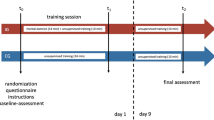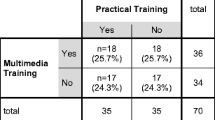Abstract
The aim of this study was to evaluate whether an assessment exercise performed on a laparoscopic trainer model reliably reflects previous laparoscopic experience and can therefore be used to accurately assess laparoscopic skills in surgical trainees. Subjects were recruited from a cross-section of surgical trainees and students at the Great Ormond Street Hospital for Children and the Institute of Child Health. Subjects were required to complete a baseline laparoscopic surgical skills questionnaire and an exercise on a new laparoscopic trainer model. Nine subjects completed both the baseline questionnaire and the exercise. These subjects exhibited a wide range of previous experience in laparoscopic surgery. Subjects with higher self-assessment scores had the lowest exercise scores (i.e. better scores; P=0.003). Furthermore, the exercise score was strongly negatively correlated with the baseline number of training modalities received (P=0.007) and the laparoscopic experience score (P=0.027). The assessment exercise on a novel laparoscopic trainer was capable of differentiating between subjects with little laparoscopic experience and those with more extensive previous laparoscopic training. The correlation between the exercise score and measured baseline variables suggests that the scoring system used in this model is sensitive and specific to measuring skills relevant to laparoscopic surgery.






Similar content being viewed by others
References
Skidmore FD (1997) Junior surgeons are becoming deskilled as result of Calman proposals. BMJ 314(7089):1281
Moorthy K, Munz Y, Sarker SK, et al (2003) Objective assessment of technical skills in surgery. BMJ 327(7422):1032–1037
Ross DG, Harris CA, Jones DJ (2002) A comparison of operative experience for basic surgical trainee in 1992 and 2000. Br J Surg 89(Suppl1):60
Issenberg SB, McGaghie WC, Hart IR, et al (1999) Simulation technology for health care professional skills training and assessment. JAMA 282(9):861–866
Derossis AM, Fried GM, Abrahamowicz M, et al (1998) Development of a model for training and evaluation of laparoscopic skills. Am J Surg 175(6):482–487
Scott DJ, Bergen PC, Rege RV, et al (2000) Laparoscopic training on bench models: better and more cost effective than operating room experience? J Am Coll Surg 191(3):272–283
Jones DB, Brewer JD, Soper NJ (1996) The influence of three-dimensional video systems on laparoscopic task performance. Surg Laparosc Endosc 6(3):191–197
Wolfe BM, Szabo Z, Moran, et al (1993) Training for minimally invasive surgery: need for surgical skills. Surg Endosc 7:93–95
Melvin WS, Johnson JA, Ellison EC (1996) Laparoscopic skills enhancement. Am J Surg 172:377–379
Dent TL (1992) Training, credentialing, and evaluation in laparoscopic surgery. Surg Clin North Am 72:1003–1030
Dagash H, Chowdhury M, Pierro A (2003) When can I be proficient in laparoscopic surgery? A systematic review of the evidence. J Pediatr Surg 38(5):720–724
Anastakis DJ, Regehr G, Reznick RK, et al (1999) Assessment of technical skills transfer from the bench training model to the human model. Am J Surg 177(2):167–170
Kumar BD, Munz Y, Moorthy K, et al (2003) How can a handful of water assess basic laparoscopic skills? Ann R Coll Surg Engl 85: 426–427
Lossing AG, Hatswell EM, Gilas T, et al (1992) A technical-skills course for 1st-year residents in general surgery: a descriptive study. Can J Surg 35(5):536–540
Rowan AN (1993) Is justification of animal research necessary? JAMA 269:1113–1114
Barnes RW, Lang NP, Whiteside MF (1989) Halstedian technique revisited. Innovations in teaching surgical skills. Ann Surg 210(1):118–121
Reznick RK (1999) Virtual reality surgical simulators: feasible but valid? J Am Coll Surg 189(1):127–128
Grantcharov TP, Bardram L, Funch-Jensen P, et al (2003) Learning curves and impact of previous operative experience on performance on a virtual reality simulator to test laparoscopic surgical skills. Am J Surg 185(2):146–149
Van Rij AM, McDonald JR, Pettigrew RA, et al (1995) Cusum as an aid to early assessment of the surgical trainee. Br J Surg 82(11):1500–1503
Powers TW, Murayama KM, Toyama M, et al (2002) Housestaff performance is improved by participation in a laparoscopic skills curriculum. Am J Surg 184(6):626–629; discussion 629–630
Traxer O, Gettman MT, Napper CA, et al (2001) The impact of intense laparoscopic skills training on the operative performance of urology residents. J Urol 166(5):1658–1661
Scott DJ, Young WN, Tesfay ST, et al (2001) Laparoscopic skills training. Am J Surg 182(2):137–142
Author information
Authors and Affiliations
Corresponding author
Appendix: Laparoscopic experience self-assessment questionnaire
Appendix: Laparoscopic experience self-assessment questionnaire
Question | |
|---|---|
1 | Gender (male/female) |
2 | Age (20–30; 30–40; 40–65 years) |
3 | Dominant hand (right/left) |
4 | Position (consultant; specialist registrar; research fellow; SHO surgery; SHO medicine; medical student) |
5 | How many years of postgraduate surgical training have you completed? (1–3; 3–8; (8 years) |
6 | How many laparoscopic surgeries have you observed, assisted, and performed? (none [0 points]; (10 [1 point]; 10–50 [2 points]; (50 [3 points]; max. score 9 points) |
7 | Have you worked with a robotic telescopic control AESOP? (no; 1–10; >10)a |
8 | Which forms of laparoscopic training have you received? (none [0 points]; on-the-job [1 points]; bench trainer [1 points]; laparoscopic course [1 points]; score 0–3) |
9 | How many laparoscopic courses have you completed? (1 course = 1 point) |
10 | What modules did these courses include?a (didactic sessions, video or live operating demonstrations, bench-trainer, training on animals, or virtual reality training; 1 point each) |
11 | Please evaluate your competency in laparoscopic motor skills? (inserting the primary trocar, inserting the secondary trocar, dissection of tissue, electrocoagulation, needle pick-up, rotation of the needle, suture placement, intracorporeal knot tying, suture cutting, clip placement, ambidextrous motor skills, and hand–eye coordination; scale from 0 to 3 (0= skills not performed; 1= beginner; 2= intermediate; and 3= advanced) |
12 | Do you feel competent about your motor skills in laparoscopic surgery? (scale 1–5; 1= not competent and 5= competent) |
13 | Are you satisfied with laparoscopic training at GOSH?a |
Rights and permissions
About this article
Cite this article
Nataraja, R.M., Ade-Ajayi, N., Holak, K. et al. Pilot study of new training model for laparoscopic surgery. Ped Surgery Int 22, 546–550 (2006). https://doi.org/10.1007/s00383-006-1665-0
Accepted:
Published:
Issue Date:
DOI: https://doi.org/10.1007/s00383-006-1665-0




